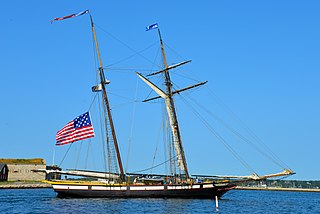
A Baltimore Clipper is a fast sailing ship historically built on the mid-Atlantic seaboard of the United States of America, especially at the port of Baltimore, Maryland. An early form of clipper, the name is most commonly applied to two-masted schooners and brigantines. These vessels may also be referred to as Baltimore Flyers.

Lynx is a square topsail schooner based in Nantucket, Massachusetts. She is an interpretation of an American letter of marque vessel of the same name from 1812. The original Lynx completed one voyage, running the Royal Navy blockade; the British captured her in 1813 at the start of her second voyage and took her into service as HMS Mosquidobit.
Three ships of the Royal Navy have been named HMS Princess Charlotte, after either Charlotte, Princess Royal, daughter of George III, or Princess Charlotte Augusta of Wales, daughter of George IV:
Eleven ships of the Royal Navy have borne the name HMS Hawk after the bird of prey, the hawk:

USS Viper – commissioned as USS Ferret – was a brig serving the United States Navy during the early days of the republic. Viper was assigned to enforce the Embargo Act of 1807 along the U.S. East Coast. During the War of 1812, while cruising in the Caribbean, she was captured by the more heavily armed British warships. She then served the Royal Navy as HMS Mohawk until the Navy sold her in 1814. While in British service she served in several actions that earned her crew the Naval General Service Medal,
HMS Highflyer was originally an American privateer schooner built in 1811. As a privateer she took several British vessels as prizes. The Royal Navy captured her in 1813. She then participated in several raids on the Chesapeake and coastal Virginia before the Americans recaptured her later in 1813.
Ten ships of the Royal Navy have borne the name HMS Confiance:
HMS Shelburne was the American letter of marque schooner Racer, built in Baltimore in 1811 and captured by the British in 1813. She served on the American coast, capturing the American brig Frolic. She also captured some merchantmen and was sold in Britain in 1817.
Many vessels have been named Minerva for the mythological figure Minerva:
HMS Whiting, built in 1811 by Thomas Kemp as a Baltimore pilot schooner, was launched as Arrow. On 8 May 1812 a British navy vessel seized her under Orders in Council, for trading with the French. The Royal Navy re-fitted her and then took her into service under the name HMS Whiting. In 1816, after four years service, Whiting was sent to patrol the Irish Sea for smugglers. She grounded on the Doom Bar. When the tide rose, she became flooded and was deemed impossible to refloat.
At least six vessels of the Royal Navy have borne the name HMS Netley, named for the village of Netley.
Several vessels have been named Recovery:
Several vessels have been named Brilliant:
Several vessels have been named Tartar:
This page is based on this
Wikipedia article Text is available under the
CC BY-SA 4.0 license; additional terms may apply.
Images, videos and audio are available under their respective licenses.


